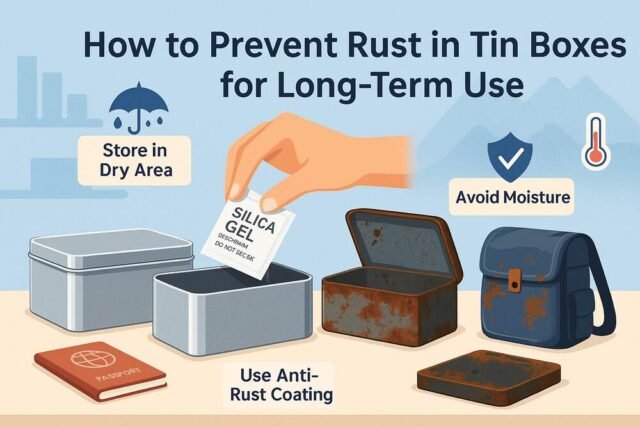Tin boxes are often chosen for their durability and charm. However, over time, rust can silently take over their beauty.
What causes rust to form and how can it be stopped?
This informative article by one of the best dry fruit tin container manufacturers is designed to uncover the most effective ways to prevent rust.
Store Tin Boxes in Dry Places
Tin boxes should always be kept in dry places. Moisture is often trapped in damp or humid areas. Rust can be quickly formed when metal stays wet. A dry shelf or cabinet should be selected carefully.
Cool and dark areas are usually better for storage. Basements and bathrooms should be avoided if possible.
Damp air can be absorbed by the box’s surface. When kept dry, tin boxes can last for years.
Keep Them Away from Direct Sunlight
Direct sunlight should always be avoided when storing tin boxes. Heat from the sun can cause air to warm up. Warm air can hold more moisture than cooler air.
When cooled later, that moisture may be released inside boxes. This trapped moisture can lead to rust over time.
Tin surfaces can also be faded by strong sunlight. A shaded and cool spot should always be chosen.
Use Silica Gel Packets Inside the Box
Silica gel packets should always be placed inside tin boxes. Moisture in the air can be absorbed by them. These packets are often found in new shoes and bags.
They help by keeping the inside of boxes very dry. Less moisture means less chance of rust forming inside.
Packets should be changed every few months for best results. Small sealed bags can also be used for added safety.
Apply a Thin Coat of Oil or Wax
A thin layer of oil or wax should be applied. Tin surfaces can be protected well with this method. Moisture and air are blocked by the coating layer.
Vegetable oil or clear wax can be gently used. A soft cloth should be used to spread it. All corners and edges must be carefully covered too.
When properly coated, tin boxes can stay safe from rust. Long-term protection can be easily achieved this way.
Do Not Wash Tin Boxes with Water
Water should not be used to clean tin boxes. Rust can be formed if water is not dried quickly. Even small water drops can lead to early rust.
A dry or slightly damp cloth should be used instead. Tin surfaces must be wiped gently to remove dust.
If washing is needed, it must be dried completely. A soft towel should be used right after cleaning.
Line the Interior with Paper or Fabric
The inside of tin boxes should be carefully lined. Soft paper or fabric can be used for this purpose.
Moisture can be trapped by items placed inside boxes. That moisture should not touch the metal surface directly.
Old newspapers or clean cotton can be gently used. The lining should be replaced if it feels damp.
Handle with Clean, Dry Hands Always
Tin boxes should be handled with clean, dry hands. Oils and sweat from skin can cause slow damage.
Before touching the box, hands should be wiped properly. Gloves can also be worn for extra protection.
The surface of tin boxes must be kept clean. A soft cloth can be used to wipe gently. With careful handling, rust can be easily prevented.
Check for Early Signs of Rust Regularly
Tin containers for food packaging should be checked at least once each month. Small rust spots can be seen on the surface early.
A soft cloth can be used to inspect gently. Corners and edges must be looked at very closely. Hidden areas are often missed during a quick check.
If rust is found, it must be cleaned immediately. A mild cleaner or baking soda can be used. Early care can stop bigger damage from happening.
FAQS
Why do tin boxes rust?
Because moisture and oxygen react with metal, forming rust over time.
Where’s the best place to store tin boxes?
In a cool, dry, shaded area. Avoid basements, bathrooms, and direct sunlight.
Can I use silica gel packs?
Yes. Place fresh packets inside to absorb moisture and replace them every few months.
Should I coat my tin box?
Applying a thin layer of vegetable oil or clear wax every few months blocks moisture.
Is it okay to wash a tin box with water?
Only if absolutely necessary. Wipe with a barely damp cloth, then dry immediately.
How can I line the interior?
Use dry paper such as newspaper or clean fabric like cotton to create a moisture barrier.
Do fingerprints cause rust?
Yes. Oils and sweat trap moisture. Handle with clean, dry hands or wear gloves.
How often should I inspect for rust?
At least monthly. Check corners, edges, and hidden spots for tiny rust flecks.
What if I spot early rust?
Gently clean with baking soda paste or a mild metal cleaner and dry thoroughly.
Any quick daily care tip?
Dust off with a soft, dry cloth to keep surfaces clean and dry.







